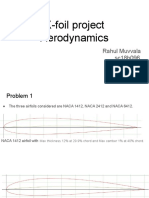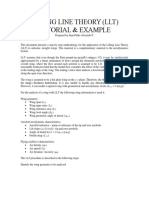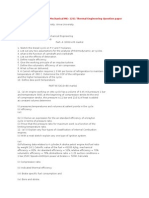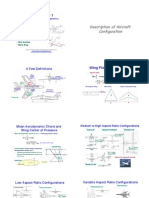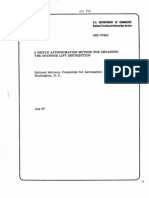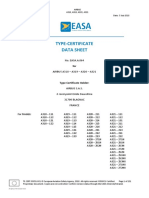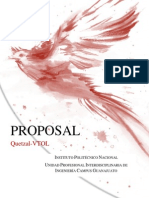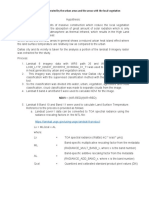007 - Chapter 2 - L5 PDF
007 - Chapter 2 - L5 PDF
Uploaded by
Jeevan BasnyatCopyright:
Available Formats
007 - Chapter 2 - L5 PDF
007 - Chapter 2 - L5 PDF
Uploaded by
Jeevan BasnyatOriginal Title
Copyright
Available Formats
Share this document
Did you find this document useful?
Is this content inappropriate?
Copyright:
Available Formats
007 - Chapter 2 - L5 PDF
007 - Chapter 2 - L5 PDF
Uploaded by
Jeevan BasnyatCopyright:
Available Formats
Flight dynamics –II Prof. E.G.
Tulapurkara
Stability and control
Chapter 2
Lecture 5
Longitudinal stick–fixed static stability and control – 2
Topics
2.2 Cmcg and Cmα as sum of the contributions of various component
2.3 Contributions of wing to Cmcg and Cmα
2.3.1 Correction to Cmαw for effects of horizontal components of lift and
drag – secondary effect of wing location on static stability
Example 2.1
Example 2.2
Example 2.3
2.2 Cmcg and Cmα expressed as sum of the contributions of various
components of the airplane
Using wind tunnel tests on a model of an airplane or by Computational
Fluid Dynamics (CFD), the Cmcg vs α curve for the entire airplane can be
obtained. However, CFD has not yet advanced enough to give accurate values of
the moments and these computations are not inexpensive. Wind tunnel tests are
very expensive and are resorted to only at the later stages of airplane design.
Hence, the usual practice to obtain the Cmcg vs α curve is to add the contributions
of major components of the airplane and at the same time take into account the
interference effects. The contributions of individual components are based on the
wind tunnel data or the analyses available in literature. References 1.1,1.8,1.9,
1.12, 2.1 and 2.2 are some of the sources of data.
The contributions to Cmcg and Cmα are due to the wing, the fuselage, the
power plant and the horizontal tail. Figure 2.8 shows the forces and moments
produced by the wing and the horizontal tail. The contributions of fuselage,
nacelle and the power plant are shown as moments about c.g. and denoted by
Mf,n,p. The fuselage reference line is denoted by FRL. It may be recalled that the
Dept. of Aerospace Engg., IIT Madras 1
Flight dynamics –II Prof. E.G. Tulapurkara
Stability and control
angle of attack (α) of the airplane is the angle between free stream velocity (V)
and FRL. The c.g. of the airplane is also shown in the figure. The wing is
represented by its mean aerodynamic chord (m.a.c.). It is set at an angle of
incidence iw to the FRL. Hence, the angle of attack of wing (αw) is α + iw.
Following the usual practice, the lift of the wing (LW) is placed at the aerodynamic
centre of the wing (a.c.) along with a pitching moment (Macw). The drag of the
wing (Dw) is also taken to act at the aerodynamic centre of the wing. The wing
a.c. is located at a distance xac from the leading edge of the m.a.c. The airplane
c.g. is at a distance xcg from the leading edge of the m.a.c.
Fig.2.8 Contributions of major components to Cmcg
The horizontal tail is also represented by its mean aerodynamic chord. The
aerodynamic centre of the tail is located at a distance lt behind the c.g. The tail is
mounted at an angle it with respect to the FRL. The lift, drag and pitching
moment due to the tail are Lt, Dt and Mact respectively. As the air flows past the
wing, it experiences a downwash ε which is shown schematically in Fig.2.8.
Owing to this the angle of attack of the horizontal tail would be (α + it - ε ).
Further, due to the interference effects the tail would experience a dynamic
pressure different from the free stream dynamic pressure. These aspects will be
Dept. of Aerospace Engg., IIT Madras 2
Flight dynamics –II Prof. E.G. Tulapurkara
Stability and control
elaborated in section 2.4.2 and 2.4.3. With this background the pitching moment
about the c.g. can be expressed as:
Mcg = (Mcg )w + (Mcg )f + (Mcg )n + (Mcg )p + (Mcg )t (2.11)
Mcg
Cmcg = = (Cmcg )w + (Cmcg )f,n,p + (Cmcg )t (2.12)
1
ρV2Sc
2
Cmα = (Cmα )w + (Cmα )f,n,p + (Cmα )t (2.13)
Note:
(i) For convenience the derivative of Cmcg with α is denoted as Cmα .
(ii) In Fig.2.8 the angle ‘it’ is shown positive for the sake of indicating the notation;
generally ‘it’ is negative.
The contributions to Cmcg and Cmα of the individual components are described in
the next four sections.
2.3 Contributions of wing to Cmcg and Cmα
Figure 2.9 schematically shows the forces (lift, Lw and drag, Dw) and the moment
(Macw) due to the wing and the relative locations of the c.g. of the airplane and the
aerodynamic centre of the wing.
The following may be recalled / noted.
i) The angle of attack of the airplane is the angle between the relative wind and
the fuselage reference line (FRL). This angle is denoted by α.
ii) The wing is represented by its mean aerodynamic chord (m.a.c.).
iii) The wing is set at an angle iw to the FRL. This is done so that the fuselage is
horizontal during cruising flight. Thus, αw = α + iw or α = αw – iw.
iv) xac is the distance of the a.c. from the leading edge of the m.a.c..
v) xcg is the distance of the c.g. from the leading edge of the m.a.c..
vi) Zcgw is the distance of the a.c. below c.g.
Dept. of Aerospace Engg., IIT Madras 3
Flight dynamics –II Prof. E.G. Tulapurkara
Stability and control
Fig.2.9 Wing contribution
Taking moment about c.g., gives the contribution of wing (Mcgw) to the moment
about c.g as:
Mcgw = L w cos(α w - iw )[x cg - x ac ] + Dw sin (αw - iw ) [x cg - x ac ]
+ L w sin(αw - iw )Zcgw - Dw cos(αw - iw )Zcgw + Macw (2.14)
Noting that,
Mcgw Lw Dw Macw
Cmcgw= ; CLw= ; CDw= ;Cmacw= , (2.15)
1 2 1 2 1 2 1 2
ρV Sc ρV S ρV S ρV Sc
2 2 2 2
yields:
x cg x ac x cg x ac
Cmcgw = CLw cos(α w - iw )[ - ] + CDw sin(α w - iw )[ - ]
c c c c
Zcgw Zcgw
+ CLw sin(α w - iw ) - CDw cos(αw - iw ) + Cmacw (2.16)
c c
Remark:
(αw – iw) is generally less than 100.Hence, cos (αw – iw) ≈ 1; and
sin(αw – iw) ≈ (αw– iw) . Further CL >> CD.
Neglecting the products of small quantities, Eq.(2.16) reduces to:
Dept. of Aerospace Engg., IIT Madras 4
Flight dynamics –II Prof. E.G. Tulapurkara
Stability and control
x cg x ac
Cmcgw = Cmacw + CLw [ - ] (2.17)
c c
Now,
CLw = CLαw (α w - α0Lw )
= CLαw (α + iw - α0Lw )
= CLαw (iw - α0Lw ) + CLαw α
= CL0w + CLαw α (2.18)
where, α0Lw is the zero lift angle of the wing and
CL0w = CLαw (iw - α0Lw )
Hence,
x cg x ac x cg x ac
Cmcgw = Cmacw + CL0w [ - ] + CLαw α [ - ] (2.19)
c c c c
Differentiating with respect to α , gives the contribution of wing to Cmα as :
x cg x ac
Cmαw = CLαw [ - ] (2.20)
c c
Remark:
The contribution of wing (Cmcgw) as approximately calculated above and given by
x cg x ac
Eq.(2.19) is linear with α. When the a.c. is ahead of c.g., the term [ - ] is
c c
positive and consequently Cmαw is positive (Eq.2.20). Since, Cmα should be
negative for static stability, a positive contribution to Cmα is called destabilizing
contribution. When the a.c. is ahead of c.g. the wing contribution is destabilizing.
Figure 2.10 shows Cmcgw vs α in this case.
Dept. of Aerospace Engg., IIT Madras 5
Flight dynamics –II Prof. E.G. Tulapurkara
Stability and control
Fig.2.10 Approximate contribution of wing to Cmcg
2.3.1 Correction to Cmαw for effects of horizontal components of lift and
drag – secondary effect of wing location on static stability
In the simplified analysis for the contribution of wing to Cmcg , the
contributions of the horizontal components of lift and drag to the moment about
c.g. , have been ignored (compare Eqs. 2.16 and 2.17).Let, the neglected terms
be denoted by Mcgwh. Equation (2.14) gives the following expression for Mmcgwh
Mcgwh = L w sin(α w - iw )Zcgw - Dw cos(αw - iw )Zcgw (2.21)
Dividing by ½ ρV2S c and noting that cos α w - iw 1 yields :
Zcgw
Cmcgwh = [CLw sin(α w -iw ) - CDw ] ; (2.22)
c
DifferentiatingEq.(2.22) with α gives:
dCLw dCDw Zcgw
Cmαwh = [ sin(αw - iw )+CLw cos(α w - iw )- ] (2.23)
dα dα c
dCLw
Now , sin(α w - iw ) CLαw (α w - iw )
dα
Dept. of Aerospace Engg., IIT Madras 6
Flight dynamics –II Prof. E.G. Tulapurkara
Stability and control
CLαw (α w - iw ) = CLαw (α w - α0L ) - CLαw (iw - α0L ) = CLw - CL0w
Further, CLw cos(α w - iw ) CLw
dCDw dCDw dCL dCDw
and = = CLαw (2.24)
dα dCL dα dCL
dCDw Zcgw
Thus, Cmαwh = [2CLw - CL0w - CLαw ] (2.25)
dCL c
The drag polar of the wing can be assumed as :
C2Lw
CDw = CD0w + ,
πAe
dCDw 2CLw
Then, =
dCL πAe
Substituting this in Eq.(2.25) yields:
2CLw Zcgw
Cmαwh = [2CLw - CL0w - CLαw ]
πAe c
CLαw Z
Cm wh = [2CLw {1 - } - CL0w ] cgw (2.26)
πAe c
The term [1 - (2CLαw / π Ae)] is generally positive. This can be seen as follows.
An approximate expression for CLαw is:
A
CLαw = 2 π ; A = Aspect ratio of wing.
A+2
Hence,
CLαw A 1 2
= 2π = (2.27)
πAe A+2 πAe (A+2)e
2/{(A+2)e} is less than 1 for typical values of A and e. Further, for low wing
aircraft, where the a.c of the wing is below c.g., the term Zcgw / c is positive
(Fig.2.9) . Hence, Cmαwh as given by Eq.(2.26) is positive or destabilizing
(Fig.2.11). For high wing aircraft, Zcgw / c is negative consequently Cmαwh is
negative and hence stabilizing (Fig.2.11).
Dept. of Aerospace Engg., IIT Madras 7
Flight dynamics –II Prof. E.G. Tulapurkara
Stability and control
Fig.2.11 Effect of wing location on Cmcgw
An important aspect of the above derivation may be pointed out here. The
expression for Cmαwh involves CL or the slope of Cmcgw vs α curve depends on CL
or α (see example 2.3) . Hence, Cmcgw become slightly non-linear. The usual
practice, is to ignore the contributions of the horizontal components to Cmαw.
However, the following aspects may be pointed out. (a) A high wing configuration
is slightly more stable than a mid-wing configuration. A low wing configuration is
slightly less stable than the mid-wing configuration. (b) In the simpler analysis
the Cmcgw vs α curve is treated as straight line but the Cmcg vs α curves, obtained
from flight tests on airplanes, are found to be slightly non-linear. One of the
reasons for the non-linearity in actual curves is the term Megwh.
Dept. of Aerospace Engg., IIT Madras 8
Flight dynamics –II Prof. E.G. Tulapurkara
Stability and control
Example 2.1
Given a rectangular wing of aspect ratio 6 and area 55.8 m2. The wing section
employed is an NACA 4412 airfoil with aerodynamic centre at 0.24 c and
Cmac = -0.088.The c.g. of the wing lies on the wing chord, but 15 cm ahead of the
a.c. Calculate the following.
(a) The lift coefficient for which the wing would be in equilibrium (Cmcg = 0). Is this
lift coefficient useful? Is the equilibrium statically stable?
(b) Calculate the position of c.g. for equilibrium at CL = 0.4. Is this equilibrium
statically stable?
Solution:
The given data for the wing are : A = 6, S = 55.8m2, Airfoil: NACA 4412; a.c. at
0.24 c , Cmac = -0.088
Before solving the problem we workout the additional data needed for the
solution.
(dCl/dα) or Clα or a0 of the given airfoil: From Ref.1.7 p.484 a0 is 0.106/degree
For a0 = 0.106 and A = 6, from Fig.5.5 of Ref.1.7, CLαw = 0.081/degree.
Note: Using CLα = (A/A+2) Clα, we would get:
CLα = {6/(6+2)}(0.106) = 0.0795 deg-1
For a rectangular wing, c = S/b
Further A = b2 / S.
Hence, b = (AxS)1/2 = (6x55.8)1/2 = 18.30 m
Consequently, c = 55.8/18.3 = 3.05 m.
Hence, xac = 0.24x3.05 = 0.732 m, xcg = 0.732 - 0.15 = 0.582 m
The configuration is shown in Fig.E2.1
Dept. of Aerospace Engg., IIT Madras 9
Flight dynamics –II Prof. E.G. Tulapurkara
Stability and control
Fig.E2.1 Configuration for example 2.1
(a) For equilibrium
L - W = 0 ; Mcg = - L x 0.15 + ½ ρ V2 S c Cmac = 0
Or – CL x 0.15 + c (- 0.088) = 0
Hence, CL = - 0.088 x 3.05/0.15 = - 1.77
This lift coefficient is not useful.
The equilibrium is stable as c.g. is ahead of a.c.
(b) Calculation of c.g. location for moment equilibrium at CL = 0.4
Cmcg = 0.4 × (x cg - x ac ) + c (- 0.088) = 0
0.088
x cg - x ac = 3.05 + = 0.671m
0.4
x cg x 0.671
or = ac + = (0.24 + 0.22) = 0.46
c c c
This equilibrium is unstable as a.c. is ahead of c.g.
Example 2.2
If the wing given example 2.1 is rebuilt maintaining the same planform, but
using reflex cambered airfoil section such that Cmac = 0.02, with the a.c. still at
0.24 c . Calculate the c.g. position for equilibrium at CL = 0.4. Is this equilibrium
statically stable?
Dept. of Aerospace Engg., IIT Madras 10
Flight dynamics –II Prof. E.G. Tulapurkara
Stability and control
Solution:
For equilibrium at CL = 0.4 with Cmac = 0.02;
Cmcg = 0.4 (x cg - x ac ) + c (0.02) = 0
x cg x ac 0.02
- = - 3.05 = -0.1525 m
c c 0.4
x cg 0.1525
= 0.24- = 0.19
c 3.05
Equilibrium is stable as c.g. is ahead of a.c.
Remark: From the above two examples we draw interesting conclusions about
an airplane which has an all wing configuration. (a) For such a configuration, the
static stability consideration requires that c.g. should be ahead of a.c.. (b) Cmac
should be positive.
Example 2.3
An airplane is equipped with a wing of aspect ratio 6 (Clαw = 0.095) and
span efficiency factor e of 0.78, with an airfoil section giving Cmac = 0.02.
Calculate, for CL between 0 and 1.2, the pitching moment coefficient of the wing
about the c.g. which is located 0.05 c ahead of a.c. and 0.06 c under a.c..
Repeat the calculations when chord wise force component is neglected. Assume
CD0w = 0.008, αoLw = 10, iw = 50.
Solution:
The given data about the wing are: A = 6, Clα = 0.095, e = 0.78, Cmac = 0.02,
αoLw = 10, CD0w = 0.008, iw = 50,
From Fig.5.5 of Ref.1.7, CLαw = 0.074 deg-1 = 4.24 rad-1
CL0w = 0.074 (5-1) = 0.296.
CL2 CL2
CDw = 0.008 + = 0.008 + = 0.008 + 0.068 CL2
πA e 3.14×6×0.78
Dept. of Aerospace Engg., IIT Madras 11
Flight dynamics –II Prof. E.G. Tulapurkara
Stability and control
Fig.E2.3 Schematic of configuration for example 2.3
Combining Eqs.(2.20) and (2.26),
(x cg - x ac ) CLαw Zcgw
Cmαw = CLαw +[2CLw {1-
} - CL0w ] ;
c πAe c
4.24
= - 0.05 × 4.24 + [2CL {1- } - 0.296] (- 0.06)
3.14×6×0.78
= - 0.212 - 0.0854 CL + 0.0178 = - 0.1942 - 0.0854 CL
Hence, Cmcgw = 0.02 + ( - 0.1942 - 0.0854 CL)α
= 0.02 + (- 0.1942 - 0.0854 CL) {(CL - CLow) / 4.24}
= 0.0336 - 0.0399CL - 0.0201 CL2
The values of Cmcgw for different values of CL are presented in table E2.3.
The approximate contribution of wing after neglecting the horizontal component
from Eq.(2.17) is :
x cg x ac
Cmcgw = Cmacw + CLw [ - ]
c c
or (Cmcgw)approximate = 0.02 - 0.05CL. These values are also included in table E2.3.
Dept. of Aerospace Engg., IIT Madras 12
Flight dynamics –II Prof. E.G. Tulapurkara
Stability and control
CL (Cmcgw) without horizontal (Cmcgw) with horizontal
component component
0 0.02 0.0336
0.4 0 0.0141
0.8 -0.02 -0.0112
1.2 -0.04 -0.04314
Table E2.3 contribution of wing to Cmg
Remark:
The c.g. is ahead of a.c , hence the contribution of wing, even without
considering horizontal component, is stabilizing. Further the c.g. is below a.c.
hence the contribution, considering the horizontal component, becomes more
stabilizing.
Dept. of Aerospace Engg., IIT Madras 13
You might also like
- CAAP PPL Exam ReviewDocument21 pagesCAAP PPL Exam ReviewKaran Tyagi86% (28)
- Atm QuestionsDocument23 pagesAtm QuestionsAziz YoussoufouNo ratings yet
- HW3Document3 pagesHW3mhmod22220% (1)
- Felis 747 IntroductionDocument18 pagesFelis 747 Introductiontheo15 collecNo ratings yet
- Firefighter Manual 2021Document162 pagesFirefighter Manual 2021Jose GonzalezNo ratings yet
- Stick-Fixed and Stick-Free Neutral PointsDocument2 pagesStick-Fixed and Stick-Free Neutral PointsSam CollieNo ratings yet
- Chapter 1Document170 pagesChapter 1Uday RaoNo ratings yet
- AE221 - Aerodynamics Xfoil Project (SC18B096) PDFDocument21 pagesAE221 - Aerodynamics Xfoil Project (SC18B096) PDFRahul Muvvala100% (1)
- Distance Measuring EquipmentDocument2 pagesDistance Measuring EquipmentvinayNo ratings yet
- BrandbookDocument20 pagesBrandbookMike WolmanNo ratings yet
- A1 10BM60005Document13 pagesA1 10BM60005amit_dce100% (2)
- Tij1o0 Spice Assign Paper Airplane Single Point Rubric 2021-22Document1 pageTij1o0 Spice Assign Paper Airplane Single Point Rubric 2021-22api-251973159No ratings yet
- Boomerang PDFDocument16 pagesBoomerang PDFYusuf SarikayaNo ratings yet
- Noorul Islam College of Engineering, KumaracoilDocument37 pagesNoorul Islam College of Engineering, KumaracoilJames PraveenNo ratings yet
- A2100 SatelliteDocument2 pagesA2100 Satellitediscovery159753No ratings yet
- Aircraft Weight EstimationDocument24 pagesAircraft Weight Estimationgiganticvis50% (2)
- Ae8501 - Flight DynamicsDocument2 pagesAe8501 - Flight DynamicsRAM PRATAP MAHATONo ratings yet
- Reaction PaperDocument27 pagesReaction PaperMikaela HipolitoNo ratings yet
- Module 11 B. Aeroplane Aerodynamics, Structures & Systems 11B.01.1. Theory of Flight Aeroplane Aerodynamics and Flight ControlsDocument231 pagesModule 11 B. Aeroplane Aerodynamics, Structures & Systems 11B.01.1. Theory of Flight Aeroplane Aerodynamics and Flight ControlsIago Cao I OlivèNo ratings yet
- Aircraft Stability and Control QuestionDocument3 pagesAircraft Stability and Control QuestionBasavaraj S KNo ratings yet
- Turbofan EngineDocument26 pagesTurbofan Engineexcel beemapallyNo ratings yet
- Why Do Planes Need Pushback TrucksDocument2 pagesWhy Do Planes Need Pushback TrucksMojdeh SoltaniNo ratings yet
- Engr 6421 - Final - Project - GR - 19Document65 pagesEngr 6421 - Final - Project - GR - 19Noel DsouzaNo ratings yet
- Multhopp Method NASADocument81 pagesMulthopp Method NASAGabriel PiresNo ratings yet
- Aircraft Performance ExerciseDocument25 pagesAircraft Performance ExercisepuneetNo ratings yet
- ATCx Honeywell Presentation PDFDocument19 pagesATCx Honeywell Presentation PDFAngelaNo ratings yet
- Boeing 787 Vs Airbus 380. Who Won or LostDocument4 pagesBoeing 787 Vs Airbus 380. Who Won or LostPriya JaiswalNo ratings yet
- AsdaDocument90 pagesAsdaCamiloRamirezSanabriaNo ratings yet
- Impact Analysis of Aircraft Using ANSYS Explicit DynamicsDocument13 pagesImpact Analysis of Aircraft Using ANSYS Explicit DynamicsOscar Oreste Salvador Carlos100% (1)
- Aircraft Design Project PDFDocument86 pagesAircraft Design Project PDFKatNo ratings yet
- There Is More Than Up-Up-And-Away To This Utilitarian PerformerDocument9 pagesThere Is More Than Up-Up-And-Away To This Utilitarian PerformerCarlos Calls MXNo ratings yet
- Design and Analysis of The Control and Stability of A Blended Wing Body Aircraft (PDFDrive)Document210 pagesDesign and Analysis of The Control and Stability of A Blended Wing Body Aircraft (PDFDrive)智飛科技TAIWAN-UAVNo ratings yet
- LIFTING LINE THEORY - Tutorial Example - PDFDocument28 pagesLIFTING LINE THEORY - Tutorial Example - PDFAlejandro SanchezNo ratings yet
- Notes On Aircraft Performance 2016v2Document58 pagesNotes On Aircraft Performance 2016v2Anonymous jyBkfI100% (1)
- Aircraft Design Project-1Document13 pagesAircraft Design Project-1KatNo ratings yet
- Aerodynamic Characterisation of Rocket F A5fda0b0Document5 pagesAerodynamic Characterisation of Rocket F A5fda0b0SamiNo ratings yet
- Exercises: Flight Dynamics-I Prof. E.G. Tulapurkara Chapter-5Document1 pageExercises: Flight Dynamics-I Prof. E.G. Tulapurkara Chapter-5Chegrani AhmedNo ratings yet
- Chapter 6 Dimensions and AreasDocument21 pagesChapter 6 Dimensions and AreasHrishikesh NarasimhanNo ratings yet
- Adams Simulation AirbusDocument3 pagesAdams Simulation AirbusAjinkya JagtapNo ratings yet
- E00090EN Rev10-Engine-Type-CertificateDocument8 pagesE00090EN Rev10-Engine-Type-CertificateIgor MedeirosNo ratings yet
- Subsonic Wind Tunnel AF100 PDFDocument4 pagesSubsonic Wind Tunnel AF100 PDFGabriel VazquezNo ratings yet
- MODEL 150 SERIES (1969 - 1976) : Supplemental Inspection Number: 55-11-02 1. TitleDocument3 pagesMODEL 150 SERIES (1969 - 1976) : Supplemental Inspection Number: 55-11-02 1. TitleRebeca SerranoNo ratings yet
- Thermal Engineering QP AuDocument14 pagesThermal Engineering QP AusaisenthNo ratings yet
- Wing Theory PDFDocument13 pagesWing Theory PDFflystudio3dNo ratings yet
- Report Metodo SchrenkDocument16 pagesReport Metodo SchrenkDario ForestiereNo ratings yet
- VT-WGL ReportDocument25 pagesVT-WGL ReportHuluguNo ratings yet
- NACA SeriesDocument31 pagesNACA SeriesAli OkumuşNo ratings yet
- Professione Volare: Domande MetereologyDocument86 pagesProfessione Volare: Domande MetereologyAkshay MaheshwariNo ratings yet
- Glossary of Airport Acronyms Used in FAA Documents - AirportsDocument42 pagesGlossary of Airport Acronyms Used in FAA Documents - AirportsArun JayankondanNo ratings yet
- Power Requirements of A VehicleDocument32 pagesPower Requirements of A VehicleAvinashRaiNo ratings yet
- Commercial Jet Aircraft: Aircraft Type Company Engine MSN Year Available Sale / Lease Contact Email PhoneDocument4 pagesCommercial Jet Aircraft: Aircraft Type Company Engine MSN Year Available Sale / Lease Contact Email PhoneFelix GenatioNo ratings yet
- Flight LabDocument4 pagesFlight LabGabriela BibiNo ratings yet
- TCDS - EASA A 064 - Airbus - A318 - A319 - A320 - A321 - Iss - 34Document49 pagesTCDS - EASA A 064 - Airbus - A318 - A319 - A320 - A321 - Iss - 34Luis Segovia0% (1)
- Linear Static Analysis of A Cantilever Beam Using Beam Library (SI Units)Document18 pagesLinear Static Analysis of A Cantilever Beam Using Beam Library (SI Units)Luis Enrique Trucios RuizNo ratings yet
- AAE 3104 CH 3 Constraint Analysis and Aircraft SizingDocument44 pagesAAE 3104 CH 3 Constraint Analysis and Aircraft SizingDpt HtegnNo ratings yet
- Textron Aviation Unveils New Large Utility Turboprop The Cessna Skycourier PDFDocument3 pagesTextron Aviation Unveils New Large Utility Turboprop The Cessna Skycourier PDFyrperdanaNo ratings yet
- AE19402 - Aircraft Performance - Question BankDocument6 pagesAE19402 - Aircraft Performance - Question BankThejeshwarrNo ratings yet
- Index: Aircraft Design Project - IIDocument56 pagesIndex: Aircraft Design Project - IIRohit MunaNo ratings yet
- 4.5 Tail Geometry and ArrangmentDocument5 pages4.5 Tail Geometry and ArrangmentpttcnNo ratings yet
- OMC Compliance ChecklistDocument4 pagesOMC Compliance ChecklistNicole FerriNo ratings yet
- Easa Mod 13Document28 pagesEasa Mod 13Abdullah Jwifall100% (1)
- REP HeliDocument18 pagesREP HeliFernando M. CastilloNo ratings yet
- Guldhammer1962 FORM DATA IDocument26 pagesGuldhammer1962 FORM DATA Irawhul setyokoNo ratings yet
- Boeing 747-400 Jumbo JetDocument8 pagesBoeing 747-400 Jumbo JetIsac Andrei RobertNo ratings yet
- Aircraft StabilityDocument13 pagesAircraft Stabilitynanduslns07No ratings yet
- 012 - Chapter 2 - L10Document12 pages012 - Chapter 2 - L10nanduslns07No ratings yet
- AIP Nepal Afis Ad 2-1 30 April 2021Document8 pagesAIP Nepal Afis Ad 2-1 30 April 2021Jeevan BasnyatNo ratings yet
- Egypt) ) : Decreased Agricultural Land in Beni SuefDocument11 pagesEgypt) ) : Decreased Agricultural Land in Beni SuefJeevan BasnyatNo ratings yet
- Part1 PDFDocument10 pagesPart1 PDFJeevan Basnyat6% (17)
- Geospatial AnalysisDocument1 pageGeospatial AnalysisJeevan BasnyatNo ratings yet
- Part3 PDFDocument10 pagesPart3 PDFJeevan BasnyatNo ratings yet
- Variation in Heat Generated by The Urban Areas and The Areas With The Local VegetationDocument3 pagesVariation in Heat Generated by The Urban Areas and The Areas With The Local VegetationJeevan BasnyatNo ratings yet
- Ac Systen ContDocument1 pageAc Systen ContJeevan BasnyatNo ratings yet
- Landing Gear, Fire ProtectionDocument42 pagesLanding Gear, Fire ProtectionJeevan BasnyatNo ratings yet
- Fuel PolicyDocument2 pagesFuel PolicyJeevan BasnyatNo ratings yet
- On Board Inert Gas Generation - Part3Document5 pagesOn Board Inert Gas Generation - Part3Jeevan BasnyatNo ratings yet
- Methods of Reducing Interference: IsolationDocument11 pagesMethods of Reducing Interference: IsolationJeevan BasnyatNo ratings yet
- Radio 2Document11 pagesRadio 2Jeevan BasnyatNo ratings yet
- Gtkad101 Toc PDFDocument3 pagesGtkad101 Toc PDFJeevan BasnyatNo ratings yet
- Genetic RecombinationDocument60 pagesGenetic RecombinationJeevan BasnyatNo ratings yet
- Anti Icing Deicing Oxyen PneumaticDocument43 pagesAnti Icing Deicing Oxyen PneumaticJeevan BasnyatNo ratings yet
- Fuel SystemDocument37 pagesFuel SystemJeevan BasnyatNo ratings yet
- ECS 455: Mobile Communications Fourier Transform and Communication SystemsDocument25 pagesECS 455: Mobile Communications Fourier Transform and Communication SystemsJeevan BasnyatNo ratings yet
- Boeing 767: From Concept To ProductionDocument15 pagesBoeing 767: From Concept To ProductionheberNo ratings yet
- NasaDocument147 pagesNasaBhawana Jain100% (1)
- Ae8751 - Avionics: Unit I Introduction To AvionicsDocument86 pagesAe8751 - Avionics: Unit I Introduction To AvionicsKannan100% (1)
- Aviation Manual AbstractDocument2 pagesAviation Manual AbstractrudiheraNo ratings yet
- Dean WilsonDocument7 pagesDean WilsonMB-RP100% (1)
- Chapter 4 Force and Newtons Laws of MotionDocument23 pagesChapter 4 Force and Newtons Laws of MotionQassem MohaidatNo ratings yet
- Aircraft PerformanceDocument54 pagesAircraft Performanceaerogem618No ratings yet
- Drone 3Document9 pagesDrone 3BBBVBVCNo ratings yet
- MIG-31 Firefox Construciton ManualDocument9 pagesMIG-31 Firefox Construciton ManualChrisNo ratings yet
- PTC A, B1.1 & B2 Basic Notes - Sub Module 8.3 (Theory of FliDocument49 pagesPTC A, B1.1 & B2 Basic Notes - Sub Module 8.3 (Theory of FlidaniaNo ratings yet
- NTSB Preliminary Crash ReportDocument2 pagesNTSB Preliminary Crash ReportKYTX CBS19No ratings yet
- Chapter 4 Drag and LiftDocument51 pagesChapter 4 Drag and LiftMohammad YunusNo ratings yet
- The Boeing 767: From Concept To Production: Case AnalysisDocument10 pagesThe Boeing 767: From Concept To Production: Case AnalysisArka BoseNo ratings yet
- PaulaDocument5 pagesPaulaJuan Camilo MurciaNo ratings yet
- Usntps FTM 103Document684 pagesUsntps FTM 103unstamper100% (1)
- Laminar Light Plane The Difficult DreamDocument11 pagesLaminar Light Plane The Difficult DreamPilot DynamicsNo ratings yet
- The 1927 Aircraft Year BookDocument414 pagesThe 1927 Aircraft Year Bookpatrick690703No ratings yet
- R/C Soaring Digest - Feb 2012Document96 pagesR/C Soaring Digest - Feb 2012Aviation/Space History Library100% (1)
- Learining CurvesDocument14 pagesLearining CurvesmsulgadleNo ratings yet
- Revised Registration - Form - B1 & B2 PDFDocument2 pagesRevised Registration - Form - B1 & B2 PDFArsalan AliNo ratings yet
- Design Build Your Own Electric RC AirplaneDocument17 pagesDesign Build Your Own Electric RC Airplanevinithkrishna20No ratings yet
- MSG3 Maintenance ProgramsDocument4 pagesMSG3 Maintenance ProgramsbudiaeroNo ratings yet
- Build The Barnaby Paper AeroplaneDocument7 pagesBuild The Barnaby Paper Aeroplanebmspam3913No ratings yet







